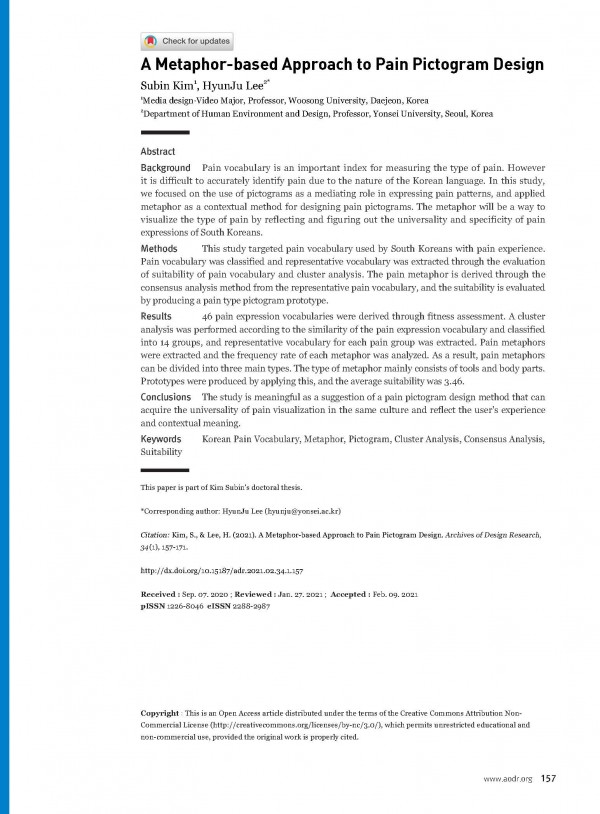논문 | A Metaphor-based Approach to Pain Pictogram Design
페이지 정보
작성자 관리자 작성일21-06-01 14:18 조회679회 댓글0건관련링크
본문
Subin Kim, & Hyunju Kim (2021). A Metaphor-based Approach to Pain Pictogram Design. Archives of Design Research, 34(1), 157-171.
DOI: https://doi.org/10.15187/adr.2021.02.34.1.157
ABSTRACT
연구배경
통증 어휘는 통증의 유형을 측정하는 데 중요한 지표지만, 한국어 특성상 통증을 정확하게 파악하는 데 어려움을 지닌다. 본 연구는 통증 양상 표현의 중재적 역할로서 픽토그램의 활용에 주목하였으며, 통증 픽토그램 디자인을 위한 맥락적 방법으로 메타포를 적용하였다. 메타포는 한국인의 통증 표현의 보편성과 통증별 특이성을 반영하고 구상화함으로써 통증 유형의 시각화 방안이 될 것이다.
연구방법
본 연구의 대상은 국어 통증 어휘이며, 대상자는 통증 경험을 가진 한국인이다. 통증 어휘의 적합성 평가와 유의성 평가를 통해 통증 어휘를 분류하고 대표 어휘를 추출하였다. 통증 대표 어휘에서 합의 분석 방법을 통해 통증 메타포를 도출하고, 통증 유형 픽토그램 프로토타입을 제작하여 적합성을 평가한다.
연구결과
적합성 평가를 통해 통증 표현 어휘 총 46개를 도출하였다. 통증 표현 어휘 간의 유사성 정도에 따라 군집 분석을 시행하여 총 14개 집단으로 분류하고 통증 군집별 대표 어휘를 추출하였다. 이를 바탕으로 통증 메타포를 추출하고 메타포별 빈도율을 분석하였다. 그 결과, 크게 세 가지 유형으로 나누어 볼 수 있었으며, 도출된 메타포의 유형은 도구와 신체 부위가 주로 나타났다. 이를 적용하여 프로토타입을 제작하였으며, 이들의 적합성 평가를 시행하여 평균 3.46으로 나타났다.
결론
동일 문화권에서 통증 시각화의 보편성을 획득하고, 사용자의 경험과 맥락적 의미를 반영할 수 있는 통증 유형 픽토그램 디자인 방법의 제안으로 의미가 있다. 환자의 통증 개념을 반영하는 실효적인 통증 유형 픽토그램 디자인 방법으로 활용이 가능할 것이다.
Background
Pain vocabulary is an important index for measuring the type of pain. However it is difficult to accurately identify pain due to the nature of the Korean language. In this study, we focused on the use of pictograms as a mediating role in expressing pain patterns, and applied metaphor as a contextual method for designing pain pictograms. The metaphor will be a way to visualize the type of pain by reflecting and figuring out the universality and specificity of pain expressions of South Koreans.
Methods
This study targeted pain vocabulary used by South Koreans with pain experience. Pain vocabulary was classified and representative vocabulary was extracted through the evaluation of suitability of pain vocabulary and cluster analysis. The pain metaphor is derived through the consensus analysis method from the representative pain vocabulary, and the suitability is evaluated by producing a pain type pictogram prototype.
Results
46 pain expression vocabularies were derived through fitness assessment. A cluster analysis was performed according to the similarity of the pain expression vocabulary and classified into 14 groups, and representative vocabulary for each pain group was extracted. Pain metaphors were extracted and the frequency rate of each metaphor was analyzed. As a result, pain metaphors can be divided into three main types. The type of metaphor mainly consists of tools and body parts. Prototypes were produced by applying this, and the average suitability was 3.46.
Conclusions
The study is meaningful as a suggestion of a pain pictogram design method that can acquire the universality of pain visualization in the same culture and reflect the user's experience and contextual meaning.
